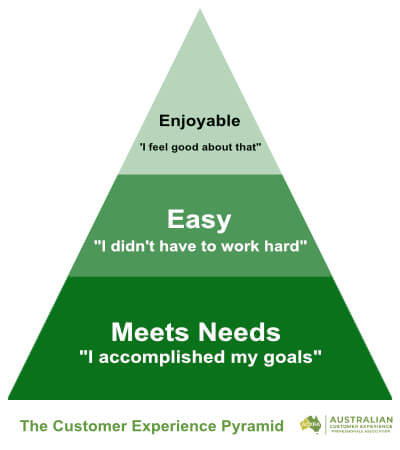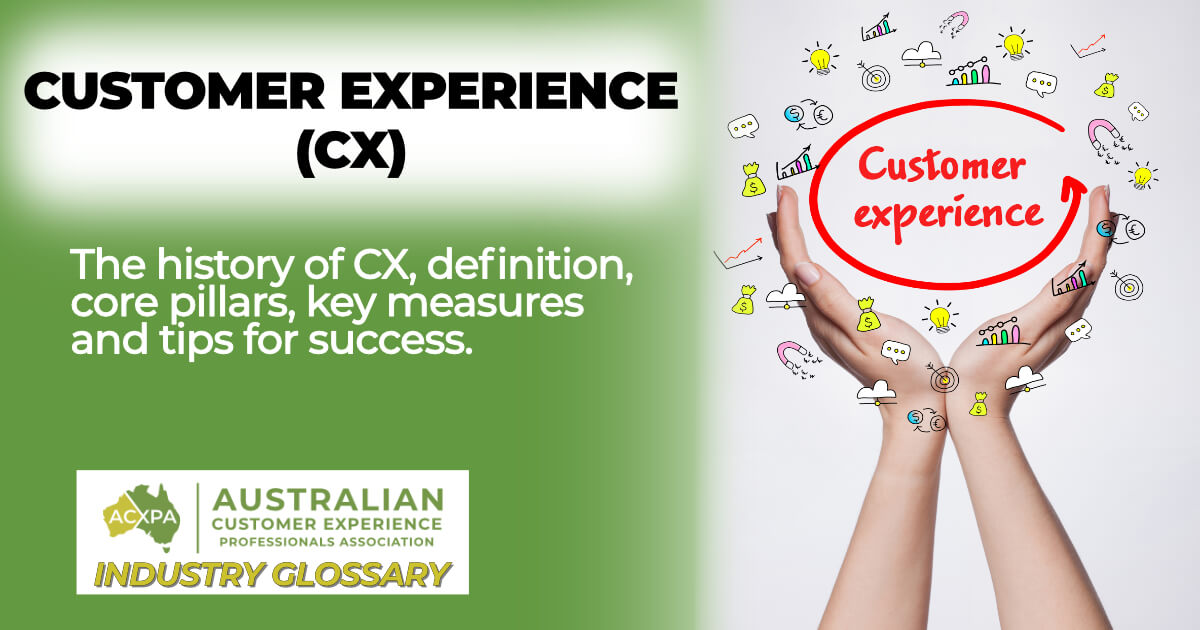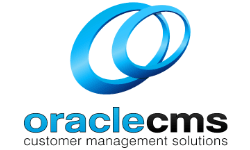Overview of Customer Experience (CX)
For professionals dedicated to shaping exceptional customer interactions, the realm of Customer Experience (CX) is a powerful force that drives success in today’s business landscape.
This glossary term delves into the essence of CX, its significance, and how it forms the bedrock of customer-centric strategies.
Of course, being Australia’s dedicated Industry Association for Customer Experience professionals, we’ve got a host of resources across the site to help you in your role today, and tomorrow and you’ll find links to key resources designed for CX professionals at the bottom of this glossary term definition.
We’ve also got some great CX stats if you need some facts and figures >
Table of Contents
Definition of CX
Customer Experience, often abbreviated as CX, encompasses the entirety of a customer’s interactions and perceptions throughout their journey with a brand.
It transcends individual touchpoints to encompass emotions, expectations, and the overall relationship customers build with a company.
From the moment they discover a product to post-purchase support, CX encapsulates every facet of their experience.
Or is it?
The challenge with defining CX to date is that it has been difficult to define – just take a look at some of the definitions out there today:
Gartner
Gartner defines customer experience as the customer’s perceptions and related feelings caused by the one-off and cumulative effect of interactions with a supplier’s employees, systems, channels or products.
McKinsey
CX, or customer experience, encapsulates everything a business or an organization does to put customers first, managing their journeys and serving their needs.
Wikipedia
Customer experience, sometimes abbreviated to CX, is the totality of cognitive, affective, sensory, and behavioural consumer responses during all stages of the consumption process including pre-purchase, consumption, and post-purchase stages.
Forbes
Customer experience describes the overall interactions a customer has had with a brand right from the point of awareness to purchase to loyalty or churn. It addresses the user’s entire buyer journey and how well they were able to “connect” with a brand.
Forrester
How customers perceive their interaction with your company
Can we do better?
The challenge with all the definitions above is that they lack the connection to acknowledge it’s a skill/profession and the ‘why’ – that it’s directly linked to better outcomes.
CEO of The Australian Customer Experience Professional Association (ACXPA), Justin Tippett, defines Customer Experience as:
Customer Experience is a skilled profession that optimises a customer’s perceptions and interactions with a brand to deliver better business outcomes.
“We have to start connecting the dots that CX is a critical business discipline that delivers benefits to businesses – whether it’s via improved profits, efficiency etc, not just because it makes customers happier.”
The Evolution of Customer Experience (CX)
It often feels like CX is a modern profession but the truth is that Customer Experience has a long and deep history.
Understanding the historical underpinnings of CX provides invaluable insights into its evolution, shaping the present and future strategies that drive customer satisfaction.

Why CX Matters
CX isn’t merely a buzzword; it’s a transformative approach that resonates across industries.
Its significance stems from the profound impact it has on business outcomes, customer loyalty, and brand advocacy.
Whilst the temptation is to reel off a long list of the benefits of investing in CX, they could be broadly categorised into these buckets:
CX Pillars for Professionals
There’s no doubt that CX compromises a range of different skills which can often make it hard to truly define a ‘CX expert’ as typically they may only specialise in one, or a couple of CX competencies.
For the purposes of trying to put CX skills into buckets/pillars, the following five are consistently referenced:
1. Understanding the Customer Journey
Map the customer journey to comprehend touchpoints, pain points, and opportunities for enhancement.
2. Empathy and Personalisation
Crafting personalised experiences resonates deeply with customers and establishes an emotional connection.
3. Effective Communication:
Transparent and efficient communication builds trust, mitigates issues, and reinforces positive perceptions.
4. Data-Driven Insights
Leverage data analytics to glean insights into customer preferences and tailor strategies accordingly.
5. Continuous Improvement
Embrace a culture of constant improvement, adapting strategies based on customer feedback and evolving trends.

What is Customer Experience Management?
Customer Experience Management is the practice applied by CX professionals who are the architects of enhancing customer experiences that deliver better outcomes for customers and the business.
Customer Experience Management objectives can encompass:
- Crafting customer-centric strategies aligned with business goals.
- Implementing cross-functional collaboration to enhance CX touchpoints.
- Monitoring customer feedback and utilising insights to refine strategies.
- Nurturing a culture of CX excellence across the organisation.
How do you measure the Customer Experience?
“What gets measured gets done” right?
When it comes to measuring the customer experience, there was been a number of different metrics developed over the years that each have pros and cons, and with the fast emergence of AI, it’s opening up even more possibilities.
Of course, as we’ve outlined CX is a wide-encompassing beast so to find a metric that can accurately capture the experience of a customer is inherently challenging, albeit many have tried!
We’ve listed some of the most common ways companies are measuring the customer experience (CX).
Net Promoter Score (NPS)
A true stalwart of CX measurement, NPS gauges customer loyalty by asking one key question: “On a scale of 0 to 10, how likely are you to recommend our product/service to others?”
Respondents are then classified as Promoters (9-10), Passives (7-8), or Detractors (0-6).
Calculating the NPS involves subtracting the percentage of Detractors from the percentage of Promoters.
Customer Satisfaction Score (CSAT)
CSAT measures the satisfaction level of customers based on a specific interaction.
It often employs a simple scale (e.g., 1 to 5) to gauge customer contentment.
It is particularly useful in understanding the effectiveness of single touchpoints or specific transactions.
CES evaluates the ease with which customers can achieve their goals while interacting with a company.
It zeroes in on the principle that reducing customer effort drives loyalty.
A question like “How much effort did you have to put into resolving your issue?” is typically used.
Customer Lifetime Value (CLTV)
A longer-term measure, CLTV quantifies the total value a customer brings to a company over their entire relationship.
It considers both the frequency of purchases and the value of those purchases, providing insights into the impact of customer retention on revenue.
Churn Rate
Churn Rate is the percentage of customers who cease their relationship with a brand over a specific time frame.
It’s a critical metric for understanding the health of customer relationships. A high churn rate signals areas for improvement in customer satisfaction and retention strategies.
Customer Retention Rate
This metric reflects the percentage of customers that a company has successfully retained over a certain period.
It’s an inverse of the churn rate and is a direct reflection of the efficacy of CX initiatives in keeping customers engaged.
First Response Time (FRT) and Resolution Time
These metrics measure the time taken to respond to customer queries and the time required to resolve their issues, respectively.
Swift response and resolution contribute to positive customer experiences and enhanced satisfaction.
Customer Feedback and Sentiment Analysis
By analysing customer feedback, businesses can gain insights into the sentiment behind their interactions.
This includes understanding not only what customers are saying but how they feel about their experiences.
How do you improve the Customer Experience?
Ah, the zillion-dollar question!
If it were easy to improve the customer experience, we wouldn’t have a growing industry of CX professionals with a vast array of skills and all businesses would be providing a fantastic customer experience.
Unfortunately, the latest industry insights and data would suggest that customers are far from glowing about the state of customer experience whether you are in Australia or from across the other side of the world.
As customer experience encompasses all customer touchpoints and interactions with your business, it goes without saying that improving the CX could involve a range of different business disciplines and skills.
But you’ve made the effort to read this far so we’re not going to leave you empty-handed!
Below we’ve listed 10 ideas on how you can improve the customer experience.
Ten Tips to Improve your Customer Experience (CX)
1. Holistically Understand Your Customer Journey
Diving deeper into the customer journey isn’t just essential; it’s imperative.
Apply advanced techniques such as customer journey mapping, which involves visualizing every touchpoint and interaction.
This comprehensive understanding allows you to pinpoint pain points and opportunities for CX enhancement.
2. Leverage Advanced Data Analytics
Go beyond the surface by harnessing the power of advanced data analytics.
Utilize predictive analytics to anticipate customer behavior, enabling you to tailor experiences before customers even express their needs.
Dive into sentiment analysis to gauge not just what customers say, but how they truly feel about their interactions.
3. Implement Hyper-Personalisation
Personalisation isn’t new, but taking it to an expert level involves crafting experiences that are virtually tailor-made for individual customers.
Utilise AI and machine learning algorithms to analyse vast data sets and create hyper-personalised interactions that anticipate needs, recommend solutions, and foster emotional connections.
4. Seamlessly Merge Channels
Integrate your channels to create an omnichannel experience that seamlessly transitions from one touchpoint to another.
This advanced approach requires intricate integration of data, allowing customers to continue conversations without losing context, irrespective of the channel.
5. Empower Agents with AI Assistance
Equip your customer service agents with AI-powered tools that provide real-time insights during interactions.
This empowers agents to offer timely solutions and personalised recommendations, enhancing the quality of each interaction.
6. Foster Proactive Engagement
Shift from reactive to proactive engagement by using predictive analytics to anticipate customer needs and address potential issues before they arise.
Initiate communications that demonstrate your commitment to customer success.
7. Implement Voice of Customer (VoC) Analytics
VoC analytics goes beyond simple feedback collection—it involves advanced sentiment analysis, natural language processing, and machine learning to extract actionable insights from customer feedback.
This approach empowers you to make data-driven decisions that align with customer desires.
8. Refine and Iterate with Agility
Expert CX professionals understand that the pursuit of excellence is an iterative process.
Continuously gather feedback, analyze results, and refine strategies with agility.
Implement A/B testing to determine the most effective approaches and strategies for different customer segments.
9. Align CX with Overall Business Strategy
Elevate CX by ensuring it aligns seamlessly with your overall business strategy.
CX shouldn’t exist in a silo; it should be intricately woven into your brand’s DNA, impacting every facet of your organisation, from marketing to product development.
10. Invest in Ongoing Training and Development
Stay at the forefront of CX innovation by investing in ongoing training and development for your CX team.
Encourage them to attend workshops, seminars, and conferences that offer insights into the latest industry trends and best practices.
We just happen to know a good place where you can find all of those things 😉
Help for CX Professionals
The Australian Customer Experience Professionals Association (ACXPA) is here to help CX professionals improve their skills, build their network and ensure they get the support they need to succeed.



























